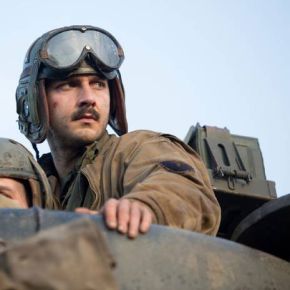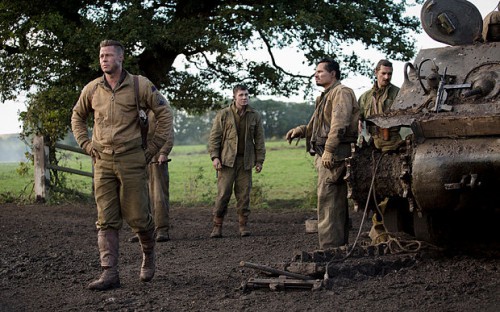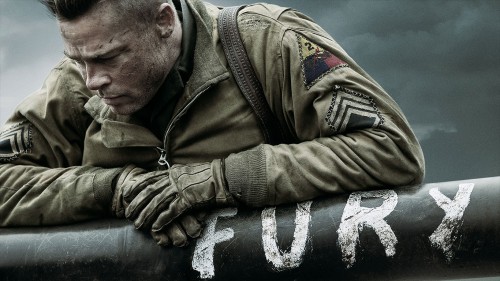
Another great contribution from Michael W. Nicholson, this reflection on the film Fury’s religious dimension first appeared on his blog, Tides of God.
The most religious film many moviegoers will see this year will not be an inspirational story from a faith-based production company; it will be writer-director David Ayer’s WWII tank combat epic Fury. And in some ways Fury is also a more compelling narrative about redemption than many of the sermons preached from Church pulpits on any given Sunday.
Fury is a slice-of-combat-life story that follows a few days’ action of a Sherman tank crew during the final campaign against Germany in April, 1945. The battle has turned into a seemingly interminable contest in which a defeated opponent refuses to quit, exacting casualties in pointless resistance. War weariness has exhausted not only men and equipment, but innocence and ideals. But Ayer, reportedly a Christian himself, isn’t just telling another war story. He is embedding and embodying the intersection of the grace of God with human history, history at its most violent and hellish.
“Ideals are peaceful. History is violent,” tank commander Sergeant Don ‘Wardaddy’ Collier (Brad Pitt) instructs green replacement Norman Ellison (Logan Lerman). It is the bullet point in the brutal lesson in the reality of warfare that Norman has been thrown into, a lesson that Collier and the rest of the tank crew—gunner Boyd ‘Bible’ Swann (Shia LaBeouf), loader Grady ‘Coon-Ass’ Travis (Jon Bernthal), and driver Trini ‘Gordo’ Garcia (Michael Peña)—have experienced together since the North African campaign in 1942. Norman’s first assignment is to clean from the tank the blood and gore and blown-off face of the assistant driver he is replacing. Swann tells him, “You’ll see …” “See what?”, Norman asks. “See what a man can do to another man.”
Ayer shows us in unrelentingly brutal detail just what that means. Limbs and heads are shot off. Artillery bursts literally blow bodies to pieces. Hit tanks “brew up”, turning into human incinerators. A man burning in agony puts a bullet in his head. Children are hanged by an SS officer. Tank treads flattens further into muddy ruts a dead soldier who is now nothing more than human roadkill. All compressed between a gloomy, lowering overcast sky and a blasted, muddy landscape. One might argue from a cinematic perspective whether Ayer is excessive, but no one who has read first-hand accounts of WWII combat (see Stephen Ambrose’s D-Day or Eugene Sledge’s With the Old Breed at Peleliu and Okinawa) can doubt that this is no visual overstatement. This is the true nature of modern mechanized warfare.
Into this nightmarish vision of mud and blood and gloom, Ayer drops the Gospel. And it rises organically from the dialogue, the imagery, and the allusions Ayer integrates into his story. “Are you saved?”, Swann asks Norman, whom Swann has pegged as a “mainliner”. “I’ve been baptized,” Norman replies. “That ain’t what he asked you,” Travis rebukes him. And we expect at this point that Ayer will use Swann’s character as a cynical and shallow stereotype to mock a certain type of earnest, but ultimately hypocritical, religionist. But Ayer subverts that expectation and draws Swann, as he draws every member of the tank crew, with depth and sympathy. Swann is as damaged in his own way as his comrades, but he doesn’t succumb to despair. We believe him when he deflects Collier’s praise for Swann’s shot that takes out a Tiger tank: “I’m just the instrument of the Lord”. We see him later kneeling beside a dying American soldier, asking gently, “Do you know Jesus?” The soldier nods. “Then everything’s going to be alright.” Ayer makes the episode almost an aside, as much a natural part of the battle as the destruction and carnage that preceded it.
The film opens with a visual reimagining of the first horseman of the Apocalypse, the rider on a “white horse” (Revelation 6:2) that symbolizes the spirit of conquest. It is a lone German officer on horseback moving slowly through a battle-devastated landscape filled with the mangled, burning remnants of machines and men. Fury and its crew seem to be the only survivors of this apocalyptic battle. Ayer disrupts this allusion when Sergeant Collier leaps on the officer from behind the turret of Fury, knocking him off his horse and killing him with a knife. We will see that horse again at the end of the movie, only this time it will be the white horse of Revelation 19:11, the symbol of Christ’s return.
In between, the story of redemption is woven into a story of battle primarily through the dialogue and interaction between Collier and Swann, facilitated by more biblical references, imagery and allusions. Building up to the climactic final combat, in which, alone, the crew must sacrifice itself to save their division from destruction, Swann begins to recite 1 John 2:15-17, “Do not love the world …”, and is surprised, as we are, when Collier continues it for him: “If anyone loves the world, the love of the Father is not in him … the world and its desires pass away …”. Swann finishes, “ …but the man who does the will of God lives forever.” This exchange becomes the benediction for the crew and a way of proclaiming that what they must do is not in vain. A bit later, cramped into the claustrophobic confines of the tank just before the Germans attack, Swann exhorts the crew, “This is a righteous act”, and quotes Isaiah 6:8, “Then I heard the voice of the Lord saying, ‘Whom shall I send? And who will go for us?’ And I said, ‘Here am I, send me.” “Isaiah chapter six,” Collier adds, and this time we are not surprised.
The final action takes place at a small crossroads, which Fury must defend against an SS battalion to prevent it from getting into the rear of the division. In a vicious night battle, Collier and his crew kill scores of Germans and prevail, but it costs the lives of all the crew but one. Only the green replacement, Norman, survives to tell the tale. As the movie ends, we see in an ascending camera shot the wrecked Fury at the center of a cross made of the intersecting dirt roads, as American soldiers and vehicles move past, back into battle.
Fury is a tense and gut-wrenching movie; chaotic, profane, and violent. It continues the paradigm of cinematic war realism begun by Steven Spielberg in Saving Private Ryan. It is a glimpse through a keyhole and a microscopic view of humanity at its worst. But we should not doubt the dictum Ayer writes into the mouth of Sergeant Collier, “Ideals are peaceful. History is violent.” History is chaotic, brutal, and violent. Christ himself entered a world and culture characterized by the brutality and oppression of the Roman Empire. The Gospel speaks in and through the wreck and ruin of humanity’s stumbling through time and space. We are saved right in the midst of the muck and gore wrought by our rebellious will. God redeems us—who we really are—and our real history, not a sanitized and safe illusion. Fury preaches this well.

COMMENTS
4 responses to “Fury at the Cross(roads): The Gospel in the Violence of History”
Leave a Reply















Excellent summation of a truly Great movie. Thanks for sharing this. You just might want to give a spoiler alert.
Someone’s been drinking out of the baptismal fount again
This is obviously a retelling of the Gospel story, however, my take on it goes like this:
It’s more of a Lucifer story, but a Lucifer that was sent by God to help humanity on our plane of existence. Here Don Collier (Pitt) is God, but he is also Jesus and Lucifer. Several examples of this…he is the snake that ‘tempts’ Norman and the german gal to get it on. Not for evil, but because of the opposite. He also remarks to the other tank crews that they’re the only tank that made it out intact because he is one of the devil’s own. His task is to lead his charges in a mortal world of sin, to get their own hands bloodied but in a cause that is just. Swann is John the baptist. There is a scene where he offers Norman a drink by kneeling and dipping his ladle into a bucket of water, thus baptizing him after Don shows Norman that the path to salvation is not an easy one. Norman and Coon Ass are regular people, one a believer, one not. Becuase Norman accepted Don and was baptized, he was saved in the end, when Don, as the embodiment of Jesus, gave his own life so that Norman could be saved.
The scene that stays with me in this film is the battle at the end when they decide to fight it out at the crossroads. It’s the metaphor of the crossroads that keeps bringing me back to the message of the film. Of course when you meet evil at the crossroads and choose to stand and fight, you will be drawn into the violence and the rage and the fury. There is no other way to prevail in that moment. The fury indeed. In this case, these soldiers of god pay the ultimate price, emboldened by their sense of faith and duty. But what are we to make of the crossroads? It is where we can change direction, continue on, return and go back, or stand our ground. It is the way that our enemy comes to us, and the way that we go to our enemy. The crossroads is where we meet our enemy whoever that may be. Are we at the crossroads now, or are we forever at the crossroads?